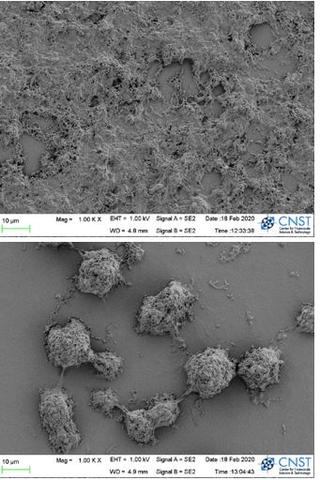Summary
The effects of biofilm physical structure on the resulting biofilm function are unclear, in part due to lack of reproducible model systems. This project aims to identify experimental parameters that modulate the physical structure of biofilms in order to develop approaches to engineer biofilm structures. The resulting in vitro model systems will help elucidate structure-function relationships, improve relevance of model biofilm systems for specific applications, and facilitate testing of biofilm and anti-biofilm products and technologies.
Description

Streptococcus mutans biofilms inoculated under different conditions have visibly different structures. Scale bars = 10 µm.
Biofilms are complex 3D microbial structures that exist throughout nature including on our skin and gut mucosa, in waterways, and in soil. They are typically composed of multiple microbial species surrounded by proteins, polysaccharides, and extracellular DNA woven together into a hydrated matrix that can resist external physical and chemical forces. Many efforts are seeking to mitigate harmful biofilm effects (e.g., medical device infections or contamination in food processing plants) and augment beneficial function (e.g., metabolizing harmful chemicals or producing biopharmaceuticals). In order to do so, model biofilm systems and reliable biofilm quantification methods are needed.
The objective of this effort is to develop approaches to engineer biofilms with specific structures
Current research is focused on developing strategies to culture repeatable model biofilm systems that are fit for purpose and demonstrate varied structures. Efforts include (1) investigating how biofilm inoculation conditions relate to the development of biofilm structure, and (2) characterizing the repeatability of biofilm structure and function measurements. The resultant biofilm structures have been extensively characterized using imaging, machine learning classification, metabolic assays, DNA and biomass measurements, and response to antimicrobial challenge. In the future, the biofilm culture conditions and quantification techniques will be extended to multispecies biofilms as tools to study how 3D organization impacts biofilm function.

